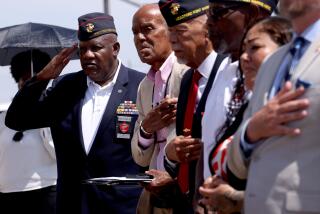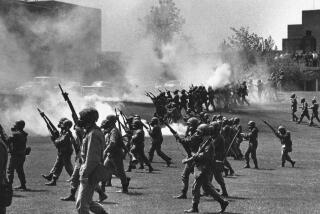Marines Waged Intense Battle for Hue : Sounds of Fighting, Dying Echo for Newsman
- Share via
In the horrors of the Tet offensive, UPI correspondent Al Webb was awarded a Bronze Star for valor, one of only three such medals awarded a civilian since World War II. Webb, now based in London, braved intense enemy fire trying to pull a wounded Marine to safety, and was injured himself in the process. “By his bold initiative and courage,” the citation reads, “Mr. Webb earned the respect, admiration and gratitude of all Marines.” Here are some of Webb’s memories of Tet.
It is noise you remember--the sharp “thwack” of a sniper’s bullets inches from your head, the eerie keening of a Marine dying of the wound that had blown away a third of his skull, the evil whoosh of a rocket seeking more death.
After 20 years, mental images of those murderous days of January-February 1968--running and crawling past rotting bodies, through the mounting rubble of Vietnam’s ancient imperial capital of Hue--are blurring and fading a bit.
What remains undiminished in memory is the cacophony of war--the sounds of men fighting and dying that greeted my arrival in Hue with a truckload of U.S. Marines up Vietnam Highway 1 on Jan. 31, 1968, and never once let up for more than five seconds in the next three weeks.
Hue, straddling the ill-named Perfume River in the northern quarter of South Vietnam, somehow had remained a haven of sanity well into the war, a city of Oriental beauty and cultural glory, of history and old tombs centered in its walled Citadel, largely bypassed by bullets and bombs.
Until, that is, just before dawn on Jan. 31, when the tide of the North Vietnamese-Viet Cong offensive at the Vietnamese Tet holiday rolled over South Vietnam and spared nothing.
By the time I arrived in Hue hours later, in a frantic dive for safety behind a low, gray stone wall across from the besieged U.S. military compound, 20th-Century warfare had horrifically transformed the city of the Nguyen emperors and their Palace of Perfect Peace, perhaps forever.
Atop the fortress gate of the Citadel itself flew the yellow-starred flag of the National Liberation Front--the Viet Cong--which for the next 25 days symbolized the meaning of the longest and bloodiest single ground action of the Tet offensive.
Hundreds on both sides would die for what that flag meant.
Two Sides of Battle
The battle was split into two: for Hue south of the river, broad boulevards flanking its respected university, mansions of the wealthy and their playground at the Cercle Sportif, and for the north side, the walled Citadel with its warrens of shops and sidewalk restaurants and, at its heart, the palace itself, with its tombs and statues of a long-dead era.
Fighting from their tiny enclave in the military compound, American Marines retook the south bank in 10 days of door-to-door combat, something even Corps veterans had not experienced since Seoul, Korea, in another war more than 15 years earlier.
Not that there was a lot to recapture. Hue University’s classrooms were battlegrounds of bullet-riddled blackboards, smashed test tubes and incinerated books.
At the Cercle Sportif, where in earlier lulls in the war I had enjoyed quiet whiskies and sweet coffees along the riverside, pool tables drenched in blackening blood served as morgue slabs for dead Marines.
Only Half Over
When Col. Ernest Cheatham’s troops finally raised the Stars and Stripes over the Thua Thien province headquarters, the battle was still only half over.
Across the river there was still the Citadel. The Marines I accompanied battled their way down the walls, gaining perhaps 100 yards a day, then falling back 50 yards at night, again and again.
One Marine pal, just back from a week’s leave in Hawaii with his wife and two children, died a few feet from me, his stomach ripped out by two bullets. Another fell with a round through his head, never seeing his baby daughter born only days before.
On Feb. 19, as a sniper’s deadly accurate fire pinned me and Marine Sgt. Steve Berntsen beneath an all-too-small wall behind a house, a bullet tore off a third of the skull of a Marine about 20 yards to my left.
Horribly, he was still alive, still conscious, still screaming for what was probably 90 seconds but seemed an hour. Then, perhaps 5 feet in front of us, a Marine sergeant was shot through the throat--a Kennedy-style wound that took off the back of his head.
Wounded by Rocket
My part in the Battle of Hue ended minutes later, in the explosion of a B-40 rocket that effectively killed the sergeant we were trying to get to safety, crippled Berntsen for life, wounded journalist David Greenway and sent me to a hospital with shrapnel wounds.
The battle lasted another five days, until the Marines--with a determination that at times seemed almost suicidal--finally pulled down that VC flag.
History records the Battle of Hue as a U.S. victory, although some war critics see it, and Tet as a whole, as the turning point from which, seven years later, the United States managed to lose the war.
Neither victory nor defeat stirs in my memory. I remember only the thunder of artillery, bombs and bullets pounding a once-proud city into wet piles of rubbish, the moans of a young father with bullets in his guts, the pitiful cries of a blond Marine who took too long to die.
Of such stuff are nightmares made, even after two decades.
More to Read
Sign up for Essential California
The most important California stories and recommendations in your inbox every morning.
You may occasionally receive promotional content from the Los Angeles Times.













